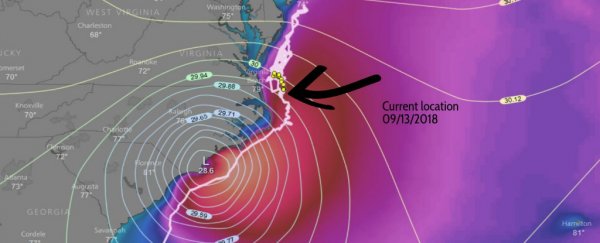Early on the night of May 5, a team of scientists snuck out onto the white beaches of south Florida to attach a transmitter in the shell of a nesting leatherback turtle (Dermochelys coriacea).
They nicknamed her Isla, and for months, members of the non-profit organisation Florida Leatherbacks, Inc. have been following this turtle as she goes about her usual motherly habits.
After nesting 11 times in one season, however, Isla found herself in a sticky situation. Unbeknownst to her, she had swum straight into Hurricane Florence.
"We're monitoring where she is right now, and it just happens to be in the middle of a hurricane," Kelly Martin, a researcher at Florida leatherbacks, told Popular Science.
Scientists are the ultimate opportunists, and this chance encounter between hurricane and leatherback offered Martin and the rest of her team a rare and fortuitous way to widen the scope of their research.
Storms are hard to predict and often it is difficult to get grants for trackers as they can cost thousands of dollars. As such, there is very little information on how sea turtles and other marine creatures navigate hurricanes.
While there is, in fact, data on how hurricanes have impacted turtle populations in the past - with a particularly heavy focus on habitat and nest destruction - a leatherback has never before been tracked in real time as it navigates such a storm.
On September 12, responding to large waves stirred up by Florence, the researchers watched as Isla made her way into deeper waters off the coast of Virginia.
At first it looked as though Isla was going to bear the brunt of the storm, but on September 14, the organisation's Twitter account announced that Isla had stopped moving south and was going about her normal business.
She was now located about 105 kilometres (65 miles) off the coast of North Carolina, sitting on the northern periphery of Florence.
"She will be experiencing high surf for the next 48 hours," the tweet warns.
Isla's behaviour has appeared to change very little over the course of the storm. With the nesting season over, she is moving offshore as Florence heads inward towards the coast.
We are tracking a leatherback sea turtle as Hurricane Florence approaches. She appears to be responding to the much larger waves (~14ft) and has begun moving southeast into deeper water. Follow along and be safe today! #HurricaneFlorence @FishOceansCAN @stormhour @Tags4Wildlife pic.twitter.com/dmhNqn2fa1
— Florida Leatherbacks (@LeatherbacksFLA) September 13, 2018
Even before the hurricane hit, Isla was experiencing swells up to four metres high (14 feet). These waves are an intimidating challenge for leatherbacks, who, like other turtles, rely on air to breathe.
Still, the tracker that is attached to Isla has given the researchers limited information on how these swells have affected her breathing. Previous research on other species of sea turtles has offered a little more insight.
A 2006 paper found that as hurricanes pass by, hawksbill turtles (Eretmochelys imbricata) tend to make shorter dives, are more active and spend less time at the surface.
"However, after passage of the hurricane the turtle quickly resumed its pre-hurricane behaviour and nested successfully a few days later," the study concludes.
"These results show that, in this case, the hurricane had a minor impact on the submerged animal presumably because of the dampening effect of depth on high winds over water."
Not all turtles are so lucky. In 2017, after a series of hurricanes in the Southeast and Gulf of Mexico, there were reports of dead and injured adult turtles washing up on shore.
Thousands of baby sea turtles were also found along Florida's coastline following Hurricane Irma, although 2,500 of them were in good enough shape to be rescued and released.
None of this is new. Hurricanes have been ravaging this region of the world for centuries, forcing sea turtle species to adapt their behaviour over the generations so they can withstand extreme storms.
For instance, many sea turtles, like Isla, stash their eggs in multiple different locations to hedge their bets against nest destruction.
But with scientists predicting more intense hurricanes in the future, and with the population of leatherback turtles decreasing at a worrying level, understanding the coping mechanisms of these marine creatures is crucial for their continued survival.
Who knows, the tracker on Isla could help us identify future strategies that will protect the health and prosperity of this already vulnerable species.
You can follow Isla's journey live on Twitter.
